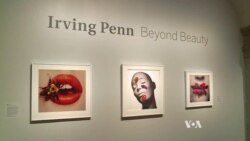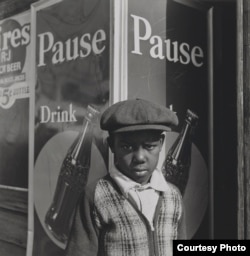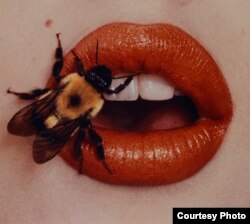Irving Penn was one of the most prominent and influential fashion and celebrity photographers of the 20th century. His images of glamorous models posing in the latest designs graced the covers and pages of the most popular fashion magazines.
In a bare, stripped-down studio in New York City, he photographed prominent figures like Spanish surrealist painter Salvador Dali, poet Langston Hughes, writer Truman Capote and pioneering architect Le Corbusier.
But Penn considered himself more an artist than a photographer.
Beyond beauty
A new exhibition titled “Irving Penn: Beyond Beauty” at the Smithsonian American Art Museum in Washington follows the full arc of Penn's seven-decade career with 146 photographs.
Exhibit curator Merry Foresta said this first retrospective since his death in 2009 proved that Penn's talent stretched far beyond the fashion world.
“He was one of the few photographers, and maybe one of the first photographers, to not only be famous in the pages of magazines like Vogue, but by the 1970s he was also being given shows at the Museum of Modern Art, he was being given shows at the Metropolitan Museum of Art, he regularly showed at art galleries,” she said.
Penn started his career in the late 1930s, photographing street scenes in places like New York and Philadelphia, and captured gritty images of storefronts and working-class people from the American South in the early 1940s.
One of Foresta's favorites is a portrait of a young boy on a street corner somewhere in the American South. He's standing in front of a Coca-Cola sign, looking directly at the camera.
"This young man has such a sense of style to him," she said. "Penn clearly selected this young man out because of the jaunty tweed cap that he's wearing and the argyle sweater that he's wearing ... and Penn thought to capture that." She added, "And I think it emboldened Penn to stand fairly close to this young man when he was making the portrait, and there seems to be some kind of a connection between them.”
But by 1950, Penn was immersed in the world of fashion and the famous in his New York studio.
“This is where he begins to photograph all the important people of New York literati life and artistic life," said Foresta. "And this is where he puts his first fashion models, in these bare corners, and creates a modernist style.”
In 1950, Penn traveled to Paris to shoot a fall couture collection for Vogue. Among his photos is one of his wife, a top fashion model, Lisa Fonssagrives-Penn, in a Rochas Mermaid Dress.
It's another of Foresta's favorites. What she finds striking about this image she explained, is how Penn has "deconstructed the whole idea of a fashion photograph." Penn used the city's beautiful northern light to illuminate his subject in his top-floor Paris studio and used an old canvas as a backdrop, giving it a textured, artistic feel. She said Penn's photo "elevates the fashion into an art form itself by virtue of making it the subject."
Beyond fashion
But Penn was just as gifted at capturing still-life images and simple portraits of ordinary people — in the U.S., Europe, and remote areas of the world such the Peruvian Andes and New Guinea — with the same spare style he used with his couture-wearing fashion models.
Over time, Penn’s style evolved as he pushed the limits of his craft to higher levels. While still distinct, these later images were bolder and more daring — and sometimes, even shocking.
“A close-up of a mouth, smeared with different-colored lipsticks and made for L’Oréal cosmetics, seems almost violent to us," said Foresta, "but it is a picture on a page in a magazine that makes us stop and think ... and that’s what his art really became about.”
While Penn may be remembered primarily as a photographer of fashion and the famous, Foresta hopes the exhibition will help visitors see a fuller, more complete version of this iconic American artist.















